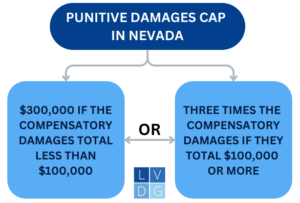As a general rule, Nevada law does not place damage caps on the amount of money you can recover for medical bills, car repairs, lost wages and similar compensatory damages in a personal injury case. However, there are three main exceptions:
- In negligence cases against public employees acting within the scope of their employment, damages are capped at $200,000 (excluding interest).1
- In medical malpractice cases, damages for pain and suffering are capped at $430,000 (for 2024).2
- Punitive damages are not recoverable at all in claims of negligence by public employees.3 In most other negligence cases, punitive damages are capped:4

To help you better understand Nevada laws on damages caps, our Nevada personal injury lawyers discuss:
- 1. Is there a cap on “economic damages” in Nevada injury cases?
- 2. Is there a cap on “pain and suffering”?
- 3. What is the “pain and suffering” cap in Nevada medical malpractice cases?
- 4. What are Nevada’s “punitive damages” caps?
- Additional resources

In Nevada, damages against public employees acting within the scope of their employment is $200,000.
1. Is there a cap on “economic damages” in Nevada injury cases?
No. There is no cap on the amount that you can recover for economic damages in a Nevada personal injury case. One exception is negligence cases against government employees acting within the scope of their employment:
- Economic damages are capped at $200,000 (minus interest), and
- You cannot recover punitive damages at all.5
Economic damage awards consist of past and anticipated future out-of-pocket costs for fixed expenses such as:
- Medical expenses,
- Property damage,
- Short- and long-term care,
- Physical and occupational therapy,
- X-rays, MRIs and other tests,
- Lost wages, and
- Lost earning capacity.
“Economic damages” are sometimes referred to in Nevada as
- “pecuniary damages” or
- “special damages.”
“Compensatory damages” comprises both economic damages and non-economic damages (discussed below).
2. Is there a cap on “pain and suffering”?
No, there is no cap on pain and suffering damages in Nevada (except in medical malpractice cases, discussed in the next section).
Pain and suffering is a type of “non-economic damages.” These are sometimes referred to as “general damages” under Nevada law.
“Non-economic” damages are those to which it is more difficult, if not impossible, to attach a precise dollar amount. They include compensation for your:
- Scarring and disfigurement,
- Inconvenience,
- Loss of function of a limb or other body part,
- Loss of enjoyment of life, and
- Pain and suffering after a Nevada injury or accident.6

Pain and suffering damages are capped in Nevada medical malpractice cases.
3. What is the “pain and suffering” cap in Nevada medical malpractice cases?
In Nevada medical malpractice cases for 2024, non-economic damages such as pain and suffering are capped at $430,000.
This cap applies to all cases based on the professional negligence of a health care provider, such as a
- Doctor,
- Chiropractor,
- Nurse or
- Hospital.
This cap also applies regardless of how many defendants are liable for an injury. So if two doctors together caused you one injury, you can still recover only $430,000 in pain and suffering for that incident in 2024.7
Note that the pain and suffering damages cap for Nevada medical malpractice cases increases with each year:
|
Year |
Medical negligence damage cap in Nevada |
| 2024 | $430,000 |
| 2025 | $510,000 |
| 2026 | $590,000 |
| 2027 | $670,000 |
| 2028 | $750,000 |
Starting in 2029, the cap will increase by 2.1% annually.8
4. What are Nevada’s “punitive damages” caps?
Nevada law places a cap on punitive damages in most personal injury cases as follows:
- $300,000 if the amount of compensatory damages awarded to you is less than $100,000, or
- Three times the amount of compensatory damages awarded to you if the amount of compensatory damages is $100,000 or more.
Though there are exceptions.
As discussed in the first section, you cannot recover punitive damages at all against government employees who were acting within the scope of their employment.
Meanwhile, punitive damages have no cap when a case involves:
- The manufacture, distribution or sale of a defective product;
- An insurer who acts in bad faith regarding its obligation to provide insurance coverage;
- Certain violations of a state or federal law prohibiting discriminatory housing practices;
- Damages or injury caused by the emission, disposal or spilling of a toxic, radioactive or hazardous material or waste;
- A violation of Nevada’s civil defamation laws;
- A car accident or other motor vehicle accident caused by a driver who willfully consumed alcohol and/or drugs.
Unlike compensatory damages, punitive damages do not serve to make you whole. Their purpose is to punish the defendant for their malicious, fraudulent, or oppressive behavior.9
Additional resources
For more in-depth information, refer to these scholarly articles:
- Statutory Punitive Damage Caps and the Profit Motive: An Economic Perspective – Emory Law Journal.
- Controlling Large Malpractice Claims: The Unexpected Impact of Damage Caps – Journal of Health Politics, Policy and Law.
- Damage Caps, Motivated Anchoring, and Bargaining Impasse – The Journal of Legal Studies.
- A Tale of Three Damage Caps: Too Much, Too Little and Finally Just Right – Case Western Reserve Law Review.
- Damage Caps and Settlement: A Behavioral Approach – The Journal of Legal Studies.
Legal references:
- NRS 41.035.
- NRS 41A.035.
- See note 1.
- NRS 42.005.
- See NRS 42. See also Wyeth v. Rowatt ()
- Same. See note 2.
- See note 2. The cap was approved as a tort reform measure by Nevada voters as part of 2004’s “Keep Our Doctors in Nevada” ballot initiative (Question No. 3). The Nevada Supreme Court has upheld the constitutionality of this cap.
- Same. Tam v. Eighth Jud. Dist. Ct. (2015) 358 P.3d 234131 Nev. Adv. Op. 80 (“NRS 41A.035 does not violate equal protection because the imposition of an aggregate cap on noneconomic damages in medical malpractice actions is rationally related to the legitimate governmental interests of ensuring that adequate and affordable health care is available to Nevada’s citizens…the noneconomic damages cap in NRS 41A.035 applies per incident, regardless of how many plaintiffs, defendants, or claims are involved…NRS 41A.035 applies to professional negligence claims, which by definition of NRS 41A.015 applies to “a provider of health care,” and includes physicians”). Note that Tam is different from the Florida Supreme Court case Estate of McCall v. United States (2014) 134 So. 3d 894, which found that damage caps did violate Equal Protection. AB 404 (2023). In 2023, the pain and suffering damages cap in Nevada medical malpractice cases was $350,000.
- See note 3. NRS 42.010.

